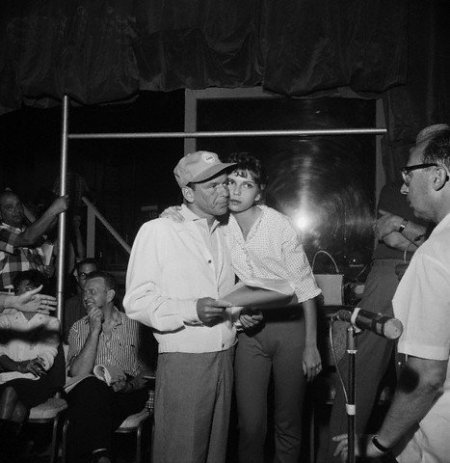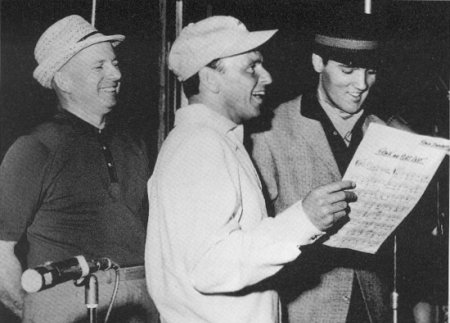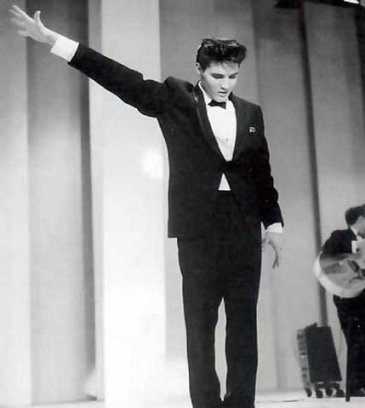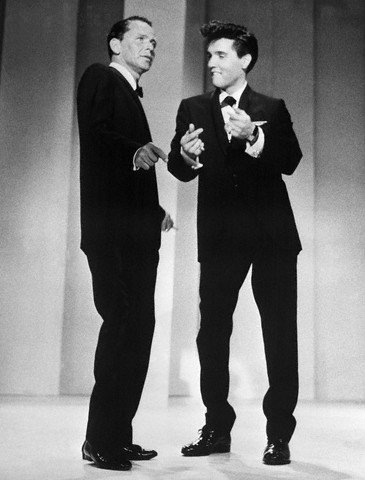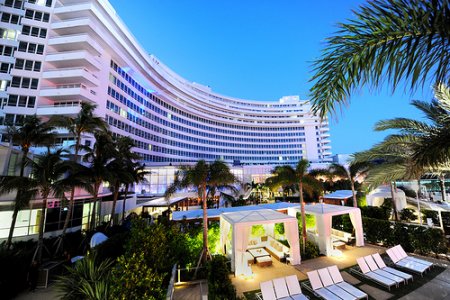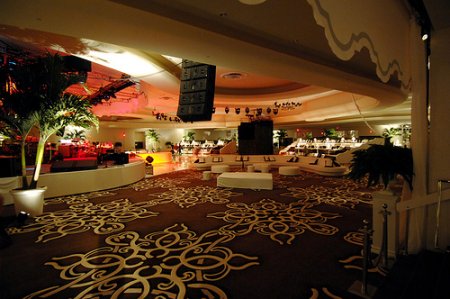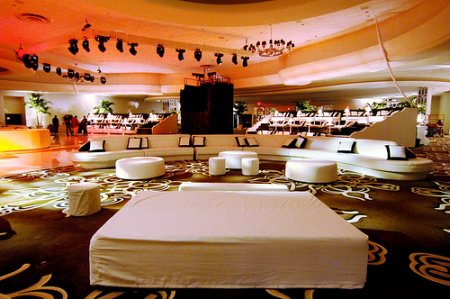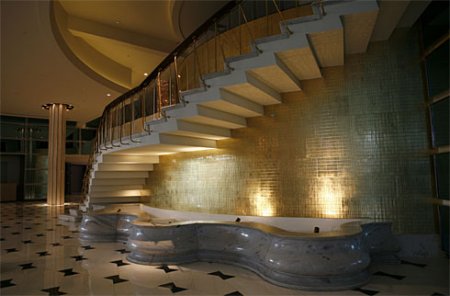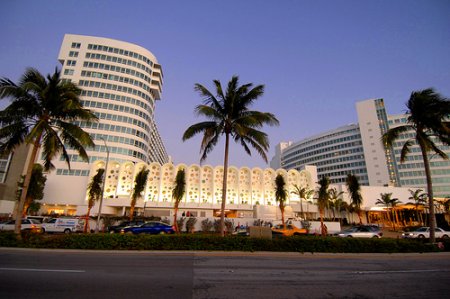 |
Fontainebleau Hotel
The Fontainebleau Hotel at 4441 Collins Avenue, Miami Beach, Florida was designed by Morris Lapidus for Ben Novak, the owner, and opened in 1954. Once the Fontainebleau opened the in-crowd nightspots gradually moved up to the ocean-front hotels along Collins Avenue from about 30th Street up thru 65th Street, and from 1954 thru 1960 there was a major shift northward for the Miami Beach nightlife scene.1
Enjoying a reputation as the area's top resort hotel, it was a favorite stopover for notables such as Frank Sinatra, Bob Hope, Sammy Davis, Jr., Lucille Ball, Jackie Gleason, Judy Garland, Milton Berle, Jerry Lewis, Marlene Dietrich, Debbie Reynolds among many others and every president since Dwight D. Eisenhower. The resort's famed crescent shape is set amid 20 lush tropical acres and accented by a magnificent grotto-style pool with cascading waterfalls. Its classic guest rooms afford spectacular water views and some are equipped with private terraces.1
The Hotel has been the setting of films like "The Bellboy," starring Jerry Lewis, "Goldfinger," starring Sean Connery as James Bond and "Scarface" that featured Al Pacino as gangster Tony Montoya. Whitney Houston sang Dolly Parton's "I Will Always Love You" from the Grand Ballroom in the 1992 movie "The Bodyguard." The Grand Ballroom was the biggest in Miami with a stage and capacity of 2200 people. In 1960 the series of four bi-monthly Frank Sinatra specials sponsored by Timex were taped from the stage of the Grand Ballroom and aired on ABC television. The series though, is most remembered for one episode which was Frank's "Welcome Home, Elvis" party taped only weeks after Elvis' return from the Army in March of 1960.
Frank was no fan of rock 'n' roll music and had had a few choice words to say about it in the past. In an oft-quoted remark to a Paris magazine in 1957, Frank Sinatra declared, "Rock 'n' roll smells phony and false. It is sung, played and written for the most part by cretinous goons and by means of its almost imbecilic reiteration, and sly, lewd, in plain fact, dirty lyrics...it manages to be the martial music of every sideburned delinquent on the face of the earth." But whatever the reason - ratings ploy or simply to placate his teenage daughter - Sinatra was feeling gracious enough to invite Presley to join him on his show.2 In fact he had sent his daughter Nancy to greet Elvis upon his arrival from Germany at McGuire Air Force base in New Jersey with a box of custom tailored shirts.
Just weeks after Elvis' discharge, Scotty and DJ reunited with Elvis again and proceeded to Nashville for their first session at Studio B. Bill Black chose not to return. After recording two ballads, "Stuck on you" and "Fame and Fortune," Elvis and the band boarded a train in Nashville and headed south to Miami on March 21st. Scotty remembers seeing people lining the tracks along the way. The trip was supposed to be secret, but Colonel Parker, in an effort to get publicity, called every small town along the way. At some stops Parker got Elvis to stand on the back platform, like he had seen some presidents do, and wave to the cheering crowds.3
When they reached Miami on the 22nd, they checked in to the Hotel Fontainebleau. For the rest of the week they rehearsed for the show. Asked if he has changed his mind and set aside his very pronounced views about rock 'n' roll (a music "for cretinous goons"), Sinatra side stepped the question, responding, "The kid's been away two years, and I get the feeling he really believes in what he's doing." The television show was taped at 6:15 p.m. in the Grand Ballroom on March 26, 1960 but it wasn't broadcast until May 12th, almost six weeks later. Elvis performed the two new songs recorded in Nashville and duets with Frank in a mutual reversal of roles, on both the host's "Witchcraft" and his own "Love Me Tender."4
Broadcast 12th May 1960 Concerned about mounting expenses, Colonel Parker hired a bus to carry the group back to Memphis. It was the only appearance/performance the band would make that year but Scotty and DJ would soon after make their final appearance in an Elvis film in GI Blues, which coincidentally featured Sinatra's current girlfriend, Juliet Prowse. Over the years other more modern hotels and properties were built, and restored boutique hotels entered the market as the Fontainebleau gradually lost its luster and many changes to the property occurred.
In March and April of 2006, items of all sorts from the Fontainebleau were sold so the hotel could be renovated. Kitchen and banquet equipment, 7,000 dishes, carpeting, early menus and silverware embossed with the hotel's name, even furnishings for a suite known as the "Goldfinger Suite" were sold in the liquidation. Sale items were priced to sell fast, with some costing as little as 25 cents.5
In November of 2008, the Hotel held a grand reopening attended by star studded guest list after a $1 billion renovation and expansion which included an 18-story, 286 all-suite tower constructed on the south end of the property. The 1,504-room complex includes a world-class 40,000-square-foot spa, 11 restaurants and lounges, 58 meeting rooms totaling 107,000 square feet, 42,000 square feet of pre-function areas and 51,000 square feet of space for hosting a variety of outdoor functions.
The Grand ballroom was also renovated and is now called the Sparkle ballroom.
The grand lobby's original white-and-black bow-tie floor pattern was recreated out of new materials, and its furrowed columns were preserved and refurbished. So too was the Fontainebleau's famed "Staircase to Nowhere," which historically led to a small coat room just above the lobby. Belles and beaus would take an elevator up, check their coats and descend the stairs for a grand entrance. The coat check is gone — not a terribly sensible feature in the tropics, anyway — but the runway remains.6
After the opening party, the Fontainebleau hosted the Victoria's Secret lingerie show — the footprint of careful calibration to recreate its sexy, stylish past and to become once again relevant, a new place to be for a new generation of pretty and cool.6 page added March 14, 2009
The Frank Sinatra Timex show and track list
presented here is courtesy the Classic Television Internet
Archive. 1
history from varied internet travel pages Through the efforts of members of the FECC and the Sinatra Family Forum we were able to connect with Stan Musick who was the Fender bass player that performed with Elvis, Scotty, and D.J. for the Sinatra show at the Fontainebleau along with Anselmo Sacasas on piano and an, as yet, unnamed upright bass player. In May of 2009 he had this to say about it, "Joe Comfort was the bass player with Nelson Riddle, I loaned him my upright bass for the session, but the photos shown were from the band that Scotty Moore hired for the session. I'm sorry to say that I don't remember the name of the upright bass player next to me in the photo. As I recall [and it's a long time ago], nobody on the band seemed to be familiar with the other musicians. Elvis stayed at a penthouse in the Fontainebleau Hotel and since I was a new addition he asked me to come up and say hello and to discuss his music. I spent an hour or so with him and he turned out to be a gentleman and a really likable young man. Since he just got out of the service, he had a tendency to call every male, "sir" and I reminded him that he was no longer in the service and he laughed really hard. I had a wonderful time with him. When I told him that I played bass on a USO Tour in Germany and that we appeared at his Army Base where he was stationed, he actually remembered the show. As a local musician, I played bass on many different occasions in the Fontainebleau Hotel. I remember playing in the La Ronde room with a large orchestra for Eddie Fischer when he was on top of his career. Also, I remember playing [at the Fontainebleau] with an orchestra from New York [can't remember the name] as a tribute to Eleanor Roosevelt [she was still alive at that time]. This is where I met Joe Comfort, the bass player with Nelson Riddle's orchestra. I believe it was the night before the Timex show and he came up to me and remarked how he liked the way my upright bass sounded. He then proceeded to tell me that he wasn't allowed to bring his upright bass [from California] and he had rented a plywood upright bass from Ace Music here in Miami. He wasn't happy with the plywood bass so I said he could use my upright bass for the Timex Show. That's how we became friends. In 1972 I was musical director at the Playboy Plaza Hotel in Miami Beach and I remember having 32 musicians for Tony Bennett and my orchestra also played for Liza Minelli, Sammy Davis, Diahann Carroll, Mitzi Gaynor and others. I'm now 80 years old and am lucky enough to still be healthy. added May 11, 2009 just to add, Scotty has said he did not hire anyone or know anyone there. He just spoke to them briefly during rehearsal and the show. It's likely that additional band members were the responsibility of and arranged through the Colonel, Tom Diskin or their contacts. He added that Elvis did not call him “sir” because of being in the service. He called everyone m’am and sir because his mother taught him that when he was very young and he continued to do so all the years Scotty knew him.
The Return of the Fontainebleau
“It’s a different glamour today, but it still has the intensity and
freshness of the 1950s with a 2008 look,” says Donald F. Wolfe, a
partner with Nichols Brosch Wurst Wolfe & Associates of Miami, the
designer of the $1 billion renovation and expansion project for
Fontainebleau Resorts of Miami Beach and Nakheel Hotels & Resorts of the
United Arab Emirates. The owners did not respond to requests for
information about the project.
reprinted Article © courtesy
Southeast Construction cover story February 2009 |
|
All photos on this site (that we didn't borrow) unless otherwise indicated are the property of either Scotty Moore or James V. Roy and unauthorized use or reproduction is prohibited. |


